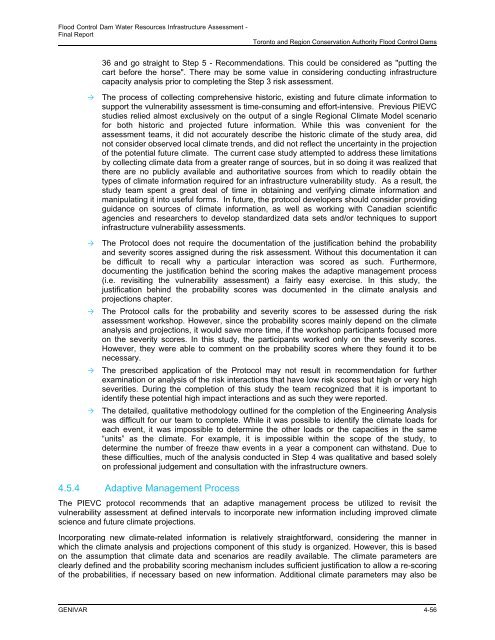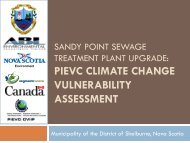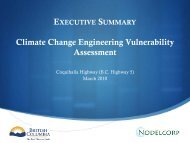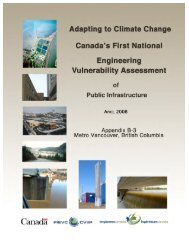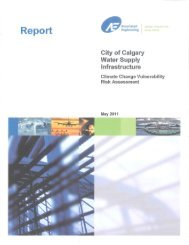Final Report - Vulnerability Committee
Final Report - Vulnerability Committee
Final Report - Vulnerability Committee
Create successful ePaper yourself
Turn your PDF publications into a flip-book with our unique Google optimized e-Paper software.
Flood Control Dam Water Resources Infrastructure Assessment -<strong>Final</strong> <strong>Report</strong>Toronto and Region Conservation Authority Flood Control Dams36 and go straight to Step 5 - Recommendations. This could be considered as "putting thecart before the horse". There may be some value in considering conducting infrastructurecapacity analysis prior to completing the Step 3 risk assessment.The process of collecting comprehensive historic, existing and future climate information tosupport the vulnerability assessment is time-consuming and effort-intensive. Previous PIEVCstudies relied almost exclusively on the output of a single Regional Climate Model scenariofor both historic and projected future information. While this was convenient for theassessment teams, it did not accurately describe the historic climate of the study area, didnot consider observed local climate trends, and did not reflect the uncertainty in the projectionof the potential future climate. The current case study attempted to address these limitationsby collecting climate data from a greater range of sources, but in so doing it was realized thatthere are no publicly available and authoritative sources from which to readily obtain thetypes of climate information required for an infrastructure vulnerability study. As a result, thestudy team spent a great deal of time in obtaining and verifying climate information andmanipulating it into useful forms. In future, the protocol developers should consider providingguidance on sources of climate information, as well as working with Canadian scientificagencies and researchers to develop standardized data sets and/or techniques to supportinfrastructure vulnerability assessments.The Protocol does not require the documentation of the justification behind the probabilityand severity scores assigned during the risk assessment. Without this documentation it canbe difficult to recall why a particular interaction was scored as such. Furthermore,documenting the justification behind the scoring makes the adaptive management process(i.e. revisiting the vulnerability assessment) a fairly easy exercise. In this study, thejustification behind the probability scores was documented in the climate analysis andprojections chapter.The Protocol calls for the probability and severity scores to be assessed during the riskassessment workshop. However, since the probability scores mainly depend on the climateanalysis and projections, it would save more time, if the workshop participants focused moreon the severity scores. In this study, the participants worked only on the severity scores.However, they were able to comment on the probability scores where they found it to benecessary.The prescribed application of the Protocol may not result in recommendation for furtherexamination or analysis of the risk interactions that have low risk scores but high or very highseverities. During the completion of this study the team recognized that it is important toidentify these potential high impact interactions and as such they were reported.The detailed, qualitative methodology outlined for the completion of the Engineering Analysiswas difficult for our team to complete. While it was possible to identify the climate loads foreach event, it was impossible to determine the other loads or the capacities in the same“units” as the climate. For example, it is impossible within the scope of the study, todetermine the number of freeze thaw events in a year a component can withstand. Due tothese difficulties, much of the analysis conducted in Step 4 was qualitative and based solelyon professional judgement and consultation with the infrastructure owners.4.5.4 Adaptive Management ProcessThe PIEVC protocol recommends that an adaptive management process be utilized to revisit thevulnerability assessment at defined intervals to incorporate new information including improved climatescience and future climate projections.Incorporating new climate-related information is relatively straightforward, considering the manner inwhich the climate analysis and projections component of this study is organized. However, this is basedon the assumption that climate data and scenarios are readily available. The climate parameters areclearly defined and the probability scoring mechanism includes sufficient justification to allow a re-scoringof the probabilities, if necessary based on new information. Additional climate parameters may also beGENIVAR 4-56


